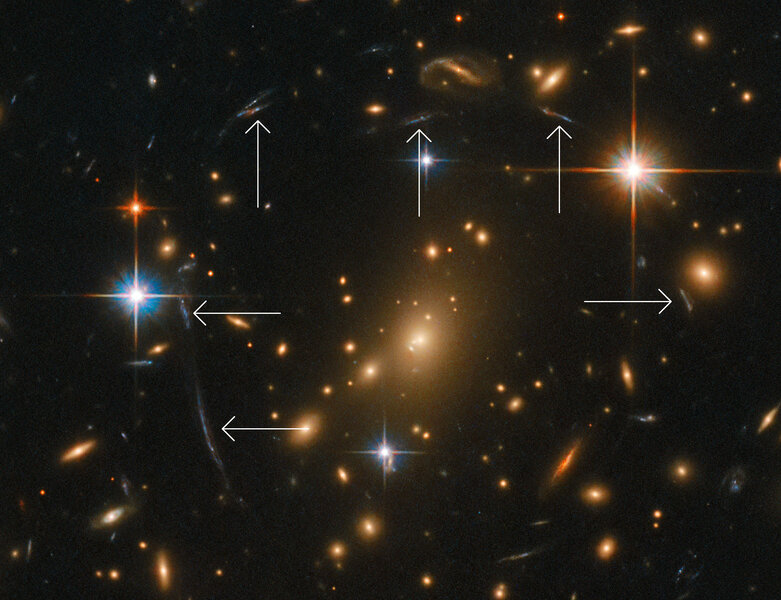Create a free profile to get unlimited access to exclusive videos, sweepstakes, and more!
Another Hubble stunner as it paves the way for JWST

James Webb Space Telescope is planned for launch in 2021*, and assuming all goes well will be as big a revolution for astronomy as Hubble was. With a mirror nearly three times the width of Hubble (and seven times the area), it will see deeper and farther than Hubble can, which means huge advances in many fields of astronomy.
Astronomers are prepping for the advent of JWST by trying to get as much information about key objects in various fields first, so that future observations can be more easily planned, executed, and analyzed.
One such target is the galaxy cluster RXC J0142.9+4438. This is a collection of hundreds of galaxies about 3 billion light years away. That’s a long way, but the point of observing it is more about what’s on the other side, even farther away…
But first, geez, take a long look at this spectacular shot of the cluster taken with the Hubble Space Telescope using observations from 2015 and 2016 and just recently released:
Oof. Wow.
This photo is made of images taken using visible light (displayed as blue), near-infrared (displayed as green), and infrared (shown as red). By far this image is heavily weighted in the infrared; the total exposure time there is more than ten times the visible light exposure! The reason for that is that JWST sees in the infrared, so Hubble was used to see as deeply in that color as possible.
You can see a lot of galaxies in this image, from spirals to ellipticals (like the giant elliptical in the center, which is common for big clusters like this; galaxies in the cluster core tend to collide and fall to the center, puffing up and forming a spheroidal galaxy there)… but you can also see weird, distended arc-shaped galaxies too. What are those?
They are not galaxies in the cluster! They lie far in the background, billions of light years more distant. As their light passes the cluster, the combined mass of the galaxies produces gravity that warps space, distorting the light from background galaxies. This is called gravitational lensing, because a lens bends light in a similar way.
The light from these more distant galaxies gets amplified by lensing, too, so they appear brighter. This means we get to see objects that would otherwise be very difficult to observe almost for free (the price we pay is that they’re all wonky from the lensing).
Hubble is looking for extremely distant galaxies here, some from the time when the Universe was so young that the first generation of stars was being born. Those galaxies will blast out ultraviolet light, but by the time it gets here, fighting the expansion of the Universe, that light is redshifted to the infrared. The lensed galaxies found by Hubble in these images will also be observed by JWST, so that we can better understand what was going on at this epoch of the early Universe.
This observation is one of many done for the RELICS (Reionization Lensing Cluster Survey) project. It’s looking at very massive galaxy clusters to maximize the chance of deep lensing of these other galaxies at the edge of the observable Universe. RXC J0142.9+4438 certainly qualifies; measurements indicate its mass is a staggering, soul-crushing 900 trillion times the mass of the Sun.
That is a lot of stars. Holy crap. That’s about a thousand times the mass of our entire Milky Way galaxy. And that only ranks number 16 by mass on the list of clusters RELICS will use Hubble to observe. The most massive, Abell 2163, has a mass equivalent to well over a quadrillion solar masses. That’s more than 1,000,000,000,000,000 times the mass of the Sun.
RELICS isn’t just using them for their mass; the astronomers hope to learn a lot about the clusters themselves. These are among the largest single structures in the entire Universe (not counting superclusters, which are clusters of clusters, in case your sense of pride and ego hasn’t already been ground into subatomic particles and spit out by all this). There’s a vast amount to learn about them.
So stay tuned. Once JWST is up and running, we'll be seeing a lot more of these. And a lot more of what they’re sitting in front of.
*JWST, if all goes as planned, will be a magnificent beast of an observatory, but cost overruns and delays have been a plague. This has been extraordinarily frustrating for me and many other astronomers. It was originally supposed to launch in 2007 and cost under a billion dollars; it has now exploded to over ten billion bucks, and honestly I have my doubts on the March 2021 target launch. I hope for the best for it, but it would be unwise for anyone to forget how bloated this project has become. We need to make sure this does not happen again with big space observatories, because it damages other projects (funding gets eaten up by overruns that would otherwise go to other worthy missions), is a huge headache for NASA and astronomy, and really just isn’t the way science should be done.




























